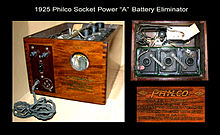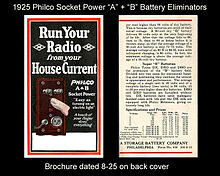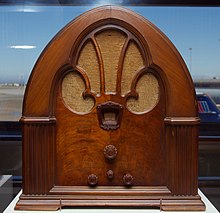Philco
| Industry | Electronics manufacturing |
|---|---|
| Founded | 1892 |
| Headquarters | , |
Area served | International |
Key people | Philo Farnsworth |
| Products | Consumer electronics |
| Parent | Philips (North America), AB Electrolux (elsewhere) |
| Website | Philco International |
Philco (founded as Helios Electric Company, renamed Philadelphia Storage Battery Company) was a pioneer in battery, radio, and television production. In 1961 the company was purchased by Ford and was known as Philco-Ford from 1966. Ford sold the company to GTE in 1974, and it was purchased by Philips in 1981. In North America, the Philco brand is currently owned by Philips. In other markets, the Philco International brand is owned by Electrolux.
In the early 1920s, Philco made storage batteries, "socket power" battery eliminator units (plug-in transformers), and battery chargers. With the invention of the rectifier tube, which made it practical to power radios by electrical outlets, in 1928, Philco entered the radio business.[1] They followed other radio makers such as RCA, Atwater-Kent, Zenith Electronics, Freshman Masterpiece, FADA Radio, and AH Grebe into the battery-powered radio business. By the end of 1930, they were selling more radios than any other maker, a position they held for more than 20 years.[2]
Philco built many iconic radios and television sets, including the classic cathedral-shaped wooden radio of the 1930s (aka the "Baby Grand"), and the Predicta series of television receiver sets of the 1950s.
Philo Farnsworth, credited for inventing the first fully functional all electronic vacuum tube television system (patent # US1773980- filed Jan 7, 1927), worked at Philco from 1931 to 1933.[3][4]
Early history[edit]
Philco was founded in 1892 as Helios Electric Company.[5] From its inception until 1904, the company manufactured carbon-arc lamps. As this line of business slowly foundered over the last decade of the 19th century, the firm experienced increasingly difficult times. As the Philadelphia Storage Battery Company, in 1906 it began making batteries for electric vehicles. They later supplied home charging batteries to the infant radio industry. The Philco brand name appeared in 1919. From 1920 to 1927, all radios were powered by storage batteries which were fairly expensive and often messy in the home.
Radios[edit]
A very successful August 1925 product, called the "Socket Power Battery Eliminator", was a rectifier unit which enabled users to operate their battery-powered radios from standard light or wall sockets. By 1927 over a million of these units had been sold, but the invention of the vacuum tube rectifier (incorporated into the coming 1928 line of radio sets) made this technology obsolete.
In 1926, Philco decided to begin making radios.[6] The first Philco radios were introduced in mid-1928, and 96,000 were produced that year, making Philco radios 26th in the nation in production volume. Up to that time most radios were handmade and priced for relatively wealthy consumers. Atwater Kent, the leading radio seller, coincidentally was also located in Philadelphia.
The Philadelphia Storage Battery Company decided that prices of radios could be scaled for a mass market by incorporating assembly line techniques then only used by the automobile industry. By the 1929 model year, Philco was in third place behind Atwater Kent and Majestic (Grigsby-Grunow Corp) in radio sales. In 1930 the company sold 600,000 radios, grossed $34 million, and was the leading radio maker in the country. By 1934 they had captured 30% of the domestic radio market.[7]
Philco radios were notable for their economy of design without sacrificing quality or durability. Like other makers of the era, they offered a wide line of radios beginning with five-tube sets all the way up to high-fidelity consoles with 20 tubes in 1937-38. Philco also made battery-powered radios which were by then called "farm radios", most of which had cabinets identical to their AC powered versions. The Philco "Baby Grand" (today called "cathedral" radios by collectors) was a shape that featured an arched top that wrapped from the sides over the top. This was for economic reason partly, as one piece of wood formed both the top and sides. Philco sold far more of this style than any other maker, a total of over two million (in over twenty models, with from four to eleven tubes) from 1930 to 1938;[8] many of them exist today in collections. By today's standards, most are still excellent performing AM band radios when restored.
A few of their innovations were very futuristic. From 1939 to 1941, they sold radios that were remotely operated by wireless controls, the one-tube "Mystery Control", used on their 13-tube model 116RX-SU (or 39-116).[9] This feature was not offered by any other maker until the 1970s stereo receivers. Philco ranked 57th among United States corporations in the value of World War II military production contracts.[10]
Another interesting product was the Philco "Beam of Light" 78 RPM record players offered in 1941 and 1942. These units had a tiny mirror attached to the player's needle. A beam of light was focused on the mirror which caused a vibrating light to hit a photoelectric cell and produce the audio signal. While this system had some advantages over the standard crystal phono cartridge of the time, it was unreliable and is today a very difficult unit to restore.


